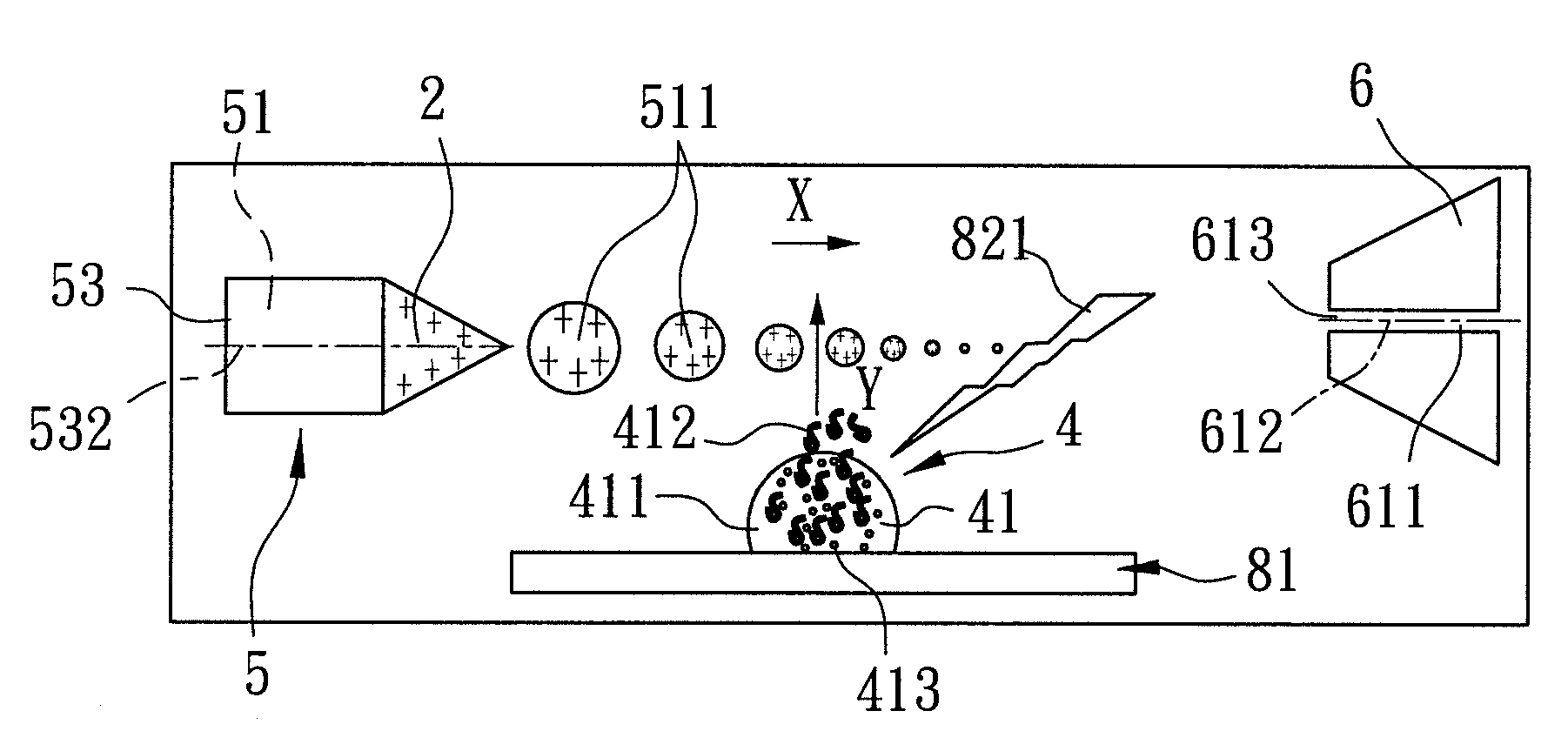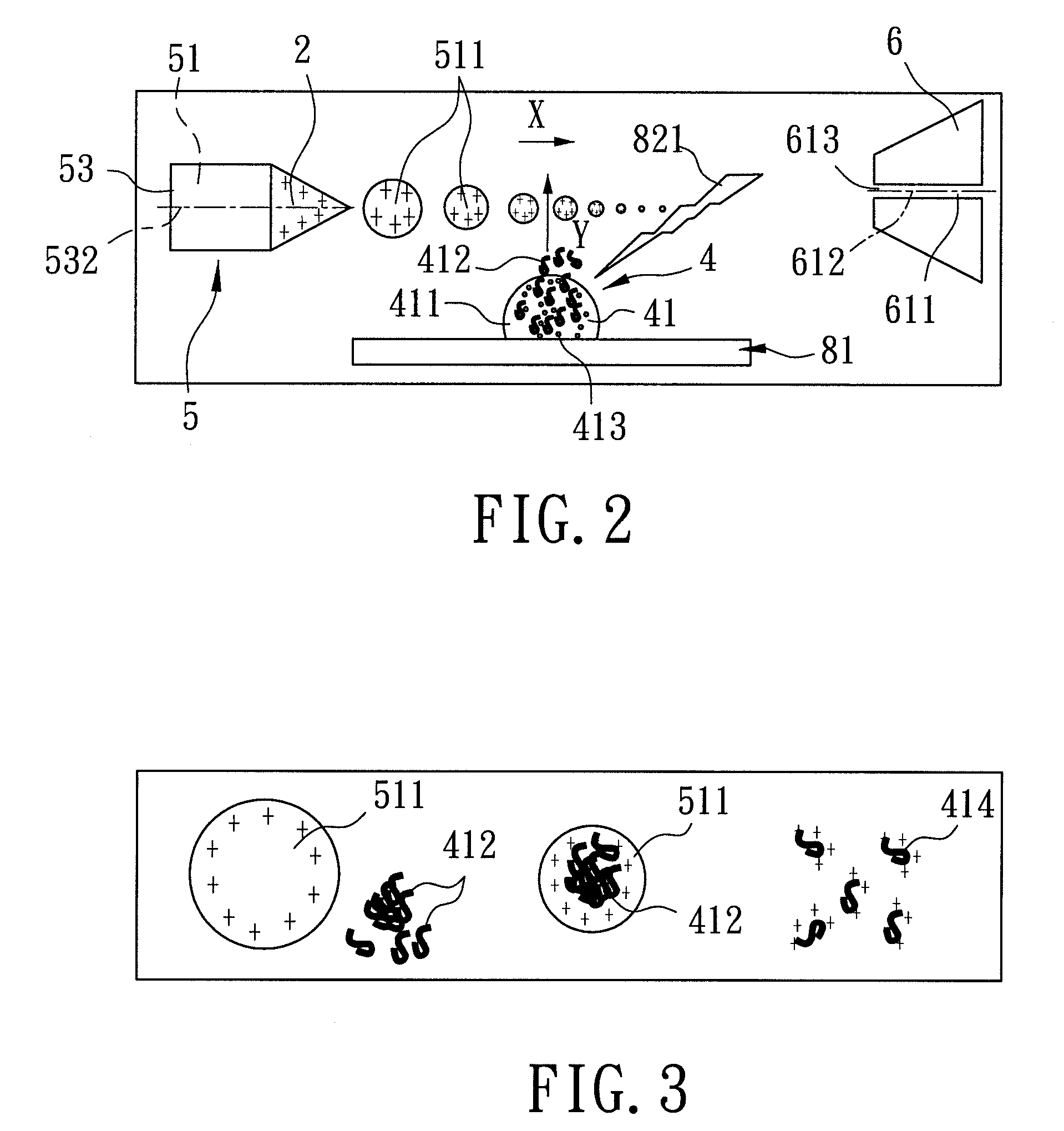Laser desorption device, mass spectrometer assembly, and method for ambient liquid mass spectrometry
a mass spectrometry and desorption device technology, applied in the field of mass spectrometry, can solve the problems of low ionization efficiency, easy interference by noise signals, and low ratio of ionized analytes
- Summary
- Abstract
- Description
- Claims
- Application Information
AI Technical Summary
Benefits of technology
Problems solved by technology
Method used
Image
Examples
second preferred embodiment
[0166]With reference to FIG. 5, the second preferred embodiment of a mass spectrometer assembly implementing the method of ambient liquid mass spectrometry according to the present invention is similar to the first preferred embodiment. The only difference between the first and second preferred embodiments is that the electrospray unit 5′ of the second preferred embodiment further includes an airstream supplying mechanism 55′ for accelerating vaporization of the multiple-charged liquid drops 511 (refer to FIGS. 2 to 4) to result in dwindling in size thereof when approaching the mass analyzer 61 (refer to FIG. 5) along the traveling path (X). The airstream supplying mechanism 55′ surrounds the nozzle 53, and supplies a nitrogen airstream 551′. In particular, the temperature of the nitrogen airstream 551′ can be controlled by the user between the room temperature and 325° C. as is required.
third preferred embodiment
[0167]As shown in FIG. 6, the third preferred embodiment of a mass spectrometer assembly implementing the method of ambient liquid mass spectrometry according to the present invention is similar to the first preferred embodiment. The difference between the first and third preferred embodiments is that the nozzle 53″ of the electrospray unit 5″ of the third preferred embodiment is made from a non-metal material, and the electrospray unit 5″ further includes a micro-tube 56″. The micro-tube 56″ includes a tubular body 561″ connected between and disposed in fluid communication with the pump 54 and the nozzle 53″, and a center portion 562″ connected to the tubular body 561″ and coupled to the voltage supplying member 3 (refer to FIG. 4) such that the potential difference is established between the micro-tube 56″ and the mass analyzer 61 of the receiving unit 6.
fourth preferred embodiment
[0168]Referring to FIG. 7, the fourth preferred embodiment of a mass spectrometer assembly implementing the method of ambient liquid mass spectrometry according to the present invention is similar to the first preferred embodiment. The difference between the first and fourth preferred embodiments is that the sample stage 81′″ of the laser desorption device 8′″ includes a movable track 814′″, and a support member set 815′″ including a plurality of support members 816′″ (only one is visible in FIG. 7) connected in sequence and mounted movably on the track 814′″.
[0169]To conduct mass spectrometric analysis using the mass spectrometer assembly of the fourth preferred embodiment, a plurality of liquid samples 4 (as shown in FIG. 4) are first contained in containers 10 (e.g., test tubes or centrifuge tubes) (only one is visible in FIG. 7), respectively. Subsequently, each of the containers 10 is disposed on a corresponding one of the support members 816′″. Through control of a computer so...
PUM
 Login to View More
Login to View More Abstract
Description
Claims
Application Information
 Login to View More
Login to View More - R&D
- Intellectual Property
- Life Sciences
- Materials
- Tech Scout
- Unparalleled Data Quality
- Higher Quality Content
- 60% Fewer Hallucinations
Browse by: Latest US Patents, China's latest patents, Technical Efficacy Thesaurus, Application Domain, Technology Topic, Popular Technical Reports.
© 2025 PatSnap. All rights reserved.Legal|Privacy policy|Modern Slavery Act Transparency Statement|Sitemap|About US| Contact US: help@patsnap.com



